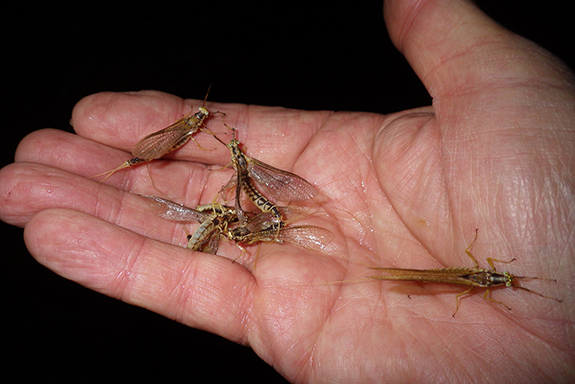The early season bug hatches are winding down and the last big hatch before the hot days of summer is upon us – the Hex hatch. With great anticipation visions of warm humid nights form in my mind with the recollection of whippoorwill calls starting just minutes before the air is filled with the rush of thousands of Hexagenia limbata mayfly spinners. This early June scene is spectacular enough to be worthy of meritorious reporting even if it is only of entomological significance, let alone the fact that trout are involved. If there is an iconic fly fishing event common to Central Wisconsin, I think of none other than that of the Hex hatch.
If this event is not well known within certain circles, it is due to the effectiveness of fishers keeping the secret. The rationale driving secrecy I think has its origin in the fact that this hatch occurs under the cover of darkness usually after 9 pm and is restricted to only certain streams. Further, the emergence period of these mayflies is a about two weeks and can be interrupted for days by cool nighttime temperatures. These factors limit fishing opportunities in both time and space, to the most astute and invested fishers.
Finding the right streams for Hex fishing can be achieved through your friendly fishing buddy, by cruising the back roads after dark looking for trucks parked at bridges and DNR parking lots or by hiring a guide. Another approach or one that will complement the aforementioned is to do your homework by spending time exploring the streams – here are some hints. Hexagenia larvae have very specific habitat needs. They live in dark sticky organically rich mucks accumulated along banks and in back-waters of streams with slow to moderately flows that meander through and adjacent to sedge meadows and marsh areas. The mayfly larvae burrow into muck because it is sticky enough to allow the larvae to create tunnels that resist collapse.
This larval home is a passageway for water movement enabling the larvae to respire and feed on food particles entering the tunnel. As you wade in search for these mucky areas, be careful since it is too easy to become stuck in the deep muck, therefore I prefer the safety of a canoe on these streams. Search the muck surface for tunnel openings readily visible as small holes placed several inches apart. The presence of Hexagenia can be verified through capturing larvae from tunnels by grabbing a handful of muck in shallow water; larvae are large enough to be easily separated out. Once a stream is located the next step is to wait for larvae to leave their tunnels, transform into adults that form mating swarms over the stream.
Scientist and fishers have unsuccessfully tried to unravel the mystery of predicting the hatch. Clearly photoperiod and water and air temperature are primary clues; however, emergence occurs as early as May 25 and maybe delayed until the latter part of June in Central Wisconsin. Further south emergence is earlier still and north near Ashland and the UP it can be a July event. A cool weather front, especially in the early days of the hatch, can interrupt the hatch for days; toward the end of the hatch period cooler temperatures appear to be less impactful.
The experienced fisher will learn which streams are the harbingers of the hatch, those that are first to produce a hatch. Likely these are streams that warm up the earliest and to put a finer point on it, certain locations within streams, typically downstream reaches, will produce a hatch before cooler up-stream reaches. This whole progression of events moves slowly from south to north across Central Wisconsin and eventually to the northern counties. Once the photoperiod criteria are satisfied, temperature directs the ebb and flow of hatches.
The term hatch is many times used generically referring to the whole adult portion of the life cycle which is composed of the dun emergence from the larval shuck and a maturation period of a few days in which the dun sheds its exoskeleton and transitions into the sexually mature spinner stage. There is value in treating the stages separately. Duns will frequently emerge, floating down from muck bars, before or just at dusk.
Positioning yourself downstream from an extensive muck flat is a rewarding experience, but be ready for a rapid switch of flies as the spinners will appear after dusk taking flight from surrounding trees and shrubs to form mating swarms. Since dun to spinner transition can take two to three days, severe weather with high winds and heavy rain will kill the spinner population holding in stream-side trees essentially eliminating successful fishing of spinners until more duns emerge.
Spinner mating swarms and their falling to the stream surface for egg laying may last 15 minutes to several hours. Submerged drowned spinners feed trout into the wee hours of the morning, so do not go home early because trout have stopped rising, they are feasting below the surface.
There are many other nuances fishers have learned that influence night-time practices in Central Wisconsin streams during the Hex season. Some are secrets, some are whispered and some are yet to be discovered. We just need to reach down into the muck and pluck out the wigglers and be ready for the spinner fall.
Credit: Source link






























